One of the most frequently asked questions I get is which drone someone should buy for drone photography in 2025. The drone market is rapidly evolving, and there are currently a lot of options on the market, so it can be hard to decide what you need. I especially find that most drone reviews are heavily focused on video, while most photographers are only interested in the photography aspect (while occasionally recording a few videos). While most drones on the market today provide great image quality, especially when using the techniques I outline in my drone photography e-book & the Drone Photography Masterclass, the choice can still be difficult. In this article, I try to create a clearer picture of what drone you should get as a photographer in 2025.
Disclaimer: This article is not sponsored in any way. However, when you make a purchase using the link in this article, I may earn a small commission. All opinions in this article are my own. If you (dis)agree, I invite you to open a discussion in the comment section. To keep this article relevant, I will keep this article updated when a new drone is released.
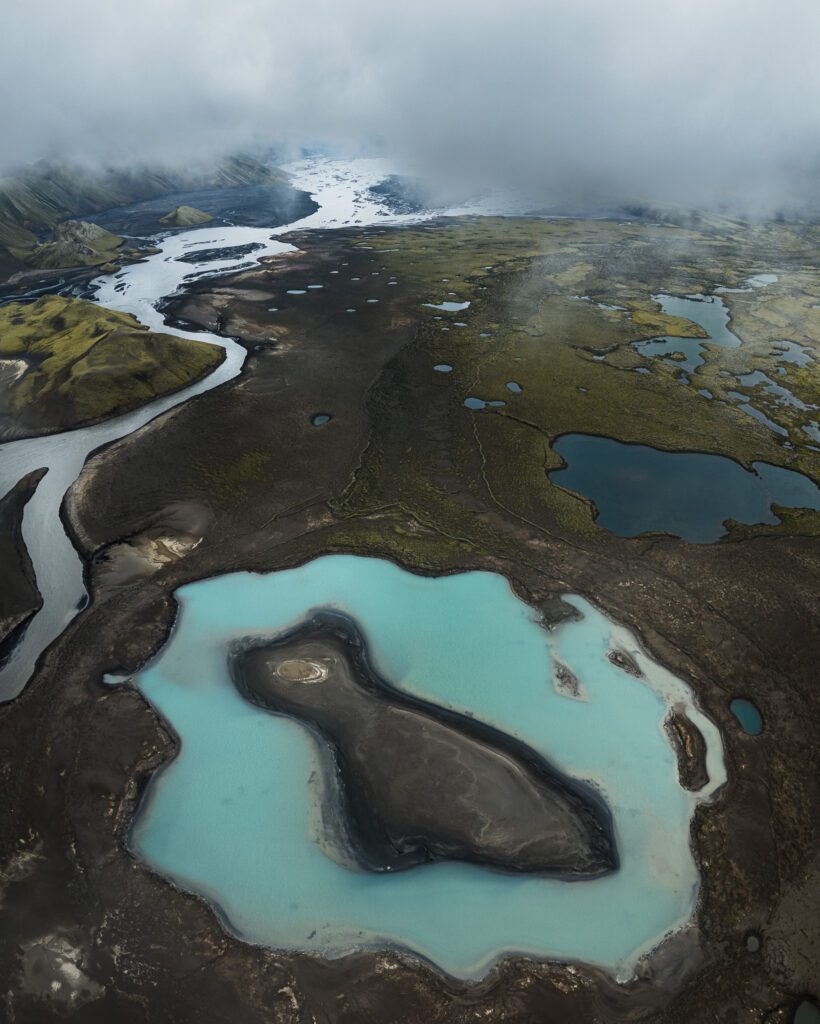
Even though its weight and build imply it’s a toy, the DJI Mini 3 Pro can give you high quality images.

Using AEB mode, you can still get really high quality out of the smaller sensor.
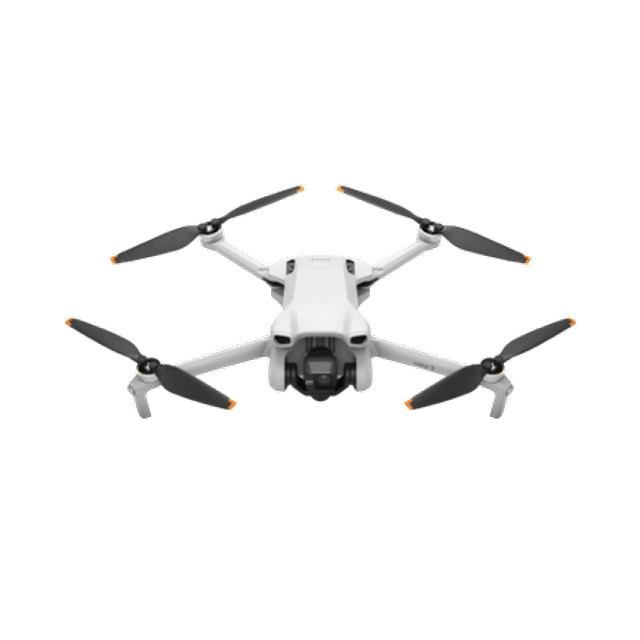
The footprint of DJI Mini 3 & DJI Mini 3 Pro is incredibly small for such capable drones.
1. The Budget Option: DJI Mini 3 & DJI Mini 3/4 Pro
On a lot of the photo workshops I host, I meet people who bring the DJI Mini 3 or DJI Mini 3 Pro, and that is for a good reason! While they are not quite the cheapest drones on the market today (that’s reserved for the still available DJI Mini 2, DJI Mini 2 SE & the newer DJI Mini 4K), they are the cheapest relevant option for photography. These drones have an image sensor that is able to produce high-quality images – especially when using the techniques described in my drone photography e-book. This is also currently the only drone on the market that has a camera module that can turn 90 degrees, allowing you to take true vertical photographs and videos. Additionally, if you are located outside of the EU, you can get larger batteries, which extend the flight time.
Important To Know: Europe’s 120 Meter Above-Takeoff-Point Altitude Limitation On C0 Drones
Given the new EU regulations that went into effect on January 1st 2024, I want to stress that all C0 drones are sold with a severe limitation when flown in the EU, being that they are capped at a maximum altitude of 120 metres above the takeoff point. This applies to any sub 250 gram drone sold globally. This could be a major issue for people flying in areas where there is a lot of height difference. It’s a quirky element in the EU law because the law in most areas stipulate you can not fly higher than 120 metres above the ground, not the takeoff point.
If you want to know more, I go deeper into this matter in a detailed blog where I advise against investing in a C0 drone.
What’s Different Between Mini 3 & Mini 3 Pro?
There are not many differences between these drones. The Mini 3 lacks the obstacle avoidance sensors the Pro versions have, while also having only Ocusync 2 instead of Ocusync 3. The latter means that the range on the Mini 3 is less. Because of the lack of obstacle avoidance sensors, the Mini 3 has a slightly better flight time. Both drones are compatible with the DJI RC and DJI RC Pro remote controllers and have the same image sensor (a 12mp 1/1.3 inch sensor).
Why Shouldn’t You Get The DJI Mini 4 Pro Instead?
While DJI has definitely added more functionality to its most lightweight drone, I don’t feel they added enough benefits over the DJI Mini 3 Pro from a photography standpoint. Improved obstacle avoidance capabilities and a better transmission system (Ocusync 4) are certainly nice additions, but they didn’t improve the most crucial part for photographers: the sensor or lens – other than a software enhanced way of reducing noise with Dual Native ISO Fusion. From my point of view, the DJI Mini 3 Pro, or even the DJI Mini 3 (if you don’t need obstacle avoidance at all), is still the better value for money as it is now cheaper and has the same photographic capabilities as the DJI Mini 4 Pro.
However, if you see the extra value in improved obstacle avoidance & a better remote controller, and don’t mind the extra cash, I can definitely recommend the DJI Mini 4 Pro.
If you want to read in more detail what the new DJI Mini 4 Pro brings to the table, you can read my detailed blog about the DJI Mini 4 Pro.
What About DJI Flip?
DJI Flip is DJI’s latest addition to its lower end drone line-up. It resembles the DJI Mini 4 Pro in many specifications but has a quirky new design, which features propeller guards. This little drone seems to be more focused on indoor environments or places where you may fly in very tight spaces.
If you want to read in more detail what the new DJI Flip to the table, you can read my detailed blog about the DJI Flip.
What I Like
- Both drones’ weight is below 250 grams, which puts them in the C0 category. This means you don’t need to get certification to fly them, while also being able to fly them in more places.
- The image quality is surprisingly good for such small drones.
- Both drones have a small footprint in your photography bag.
- Because of the low battery capacity, batteries charge very quickly.
- The camera module can turn 90 degrees so you can take true vertical images.
What I Don’t Like
- These drones are very light, maybe even too light, which means they can struggle in windy environments. In strong winds, these drones have less stability compared to heavier ones, resulting in faster battery drain and a higher chance of motion blur in photographs and unstable videos.
- The sensor is only 12 megapixels.
- Taking bracketed shots can take much longer than on more expensive drones.
- Single shots aren’t particularly usable for prints.
- Replacing the propellers is a pain as it requires a special screwdriver (which comes in the box).
- The larger and heavier batteries are not available on the EU market as that puts the drone over 250 grams.
- These drones could become very limited if their allowed height is capped at 120 metres with a new firmware update (see below)
Buy the DJI Mini 3: https://geni.us/jvn-djimini3
See the full specifications: https://www.dji.com/mini-3/specs
Buy the DJI Mini 3 Pro: https://geni.us/jvn-djimini3pro
See the full specifications: https://www.dji.com/mini-3-pro/specs
Buy the DJI Mini 4 Pro: https://geni.us/jvn-djimini4pro
See the full specifications: https://www.dji.com/mini-4-pro/specs
Buy the DJI Flip: https://geni.us/jvn-djiflip
See the full specifications: https://www.dji.com/flip/specs
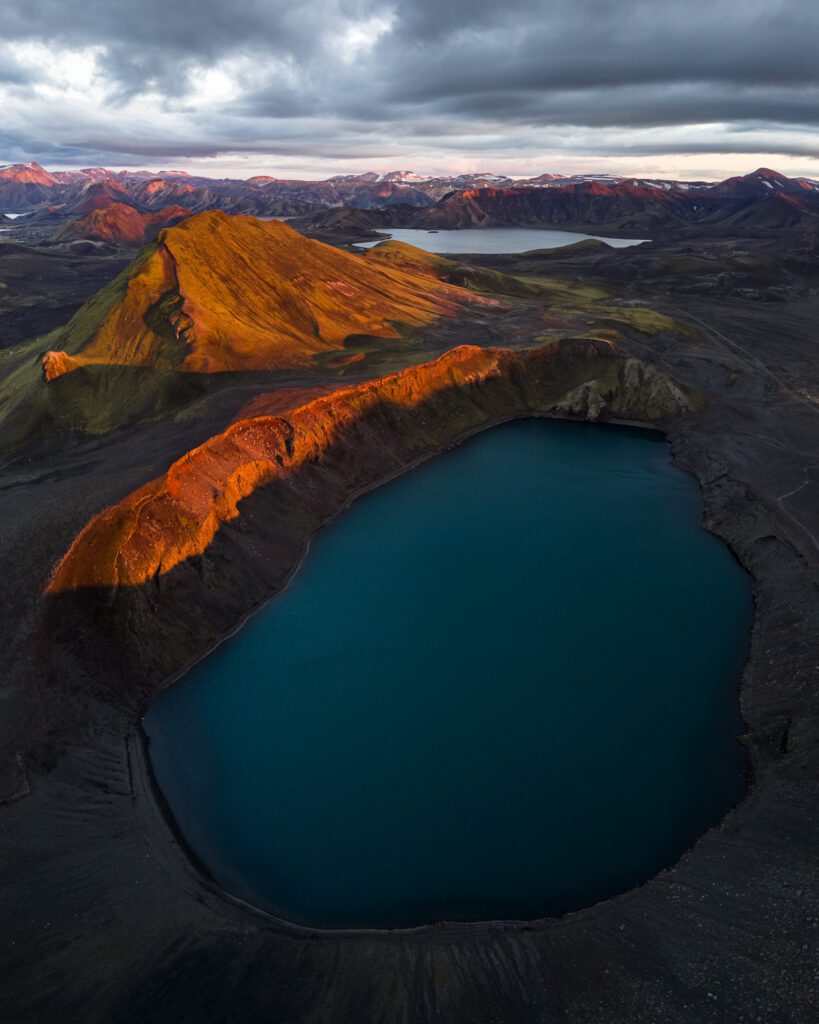
Even though the sensors are only 12 megapixels, they can still capture vibrant high quality images.
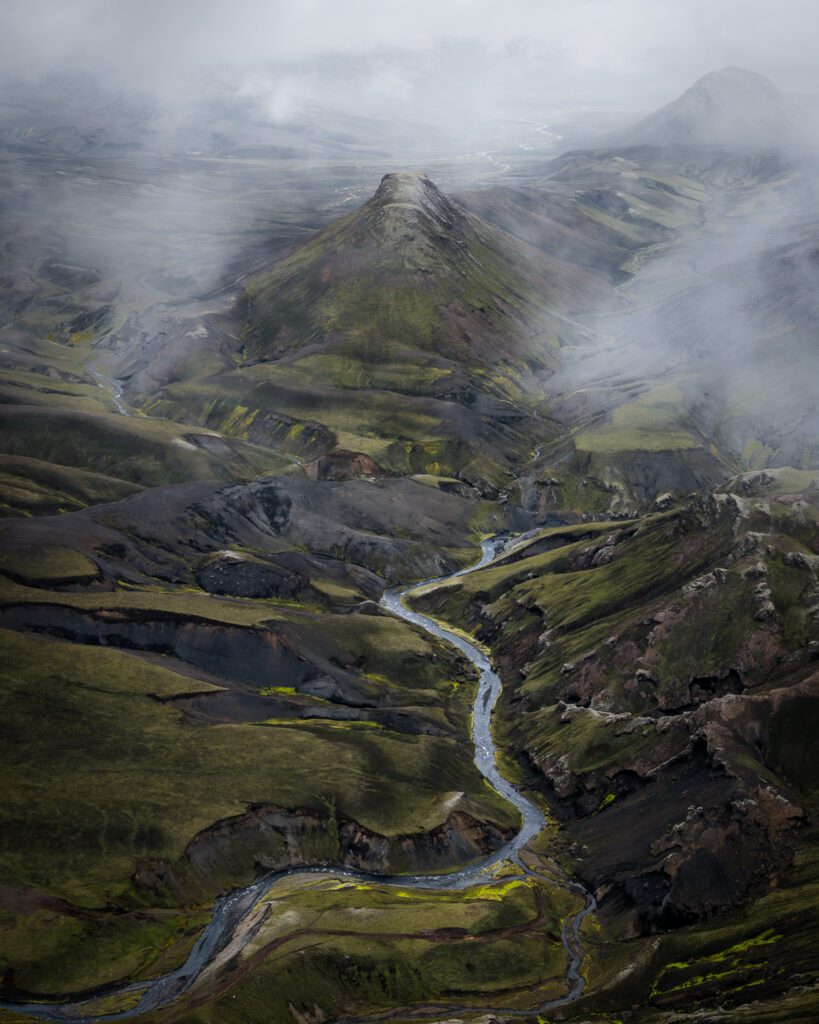
Having the 3x telephoto lens at your disposal means you can capture different angles to familiar scenes.
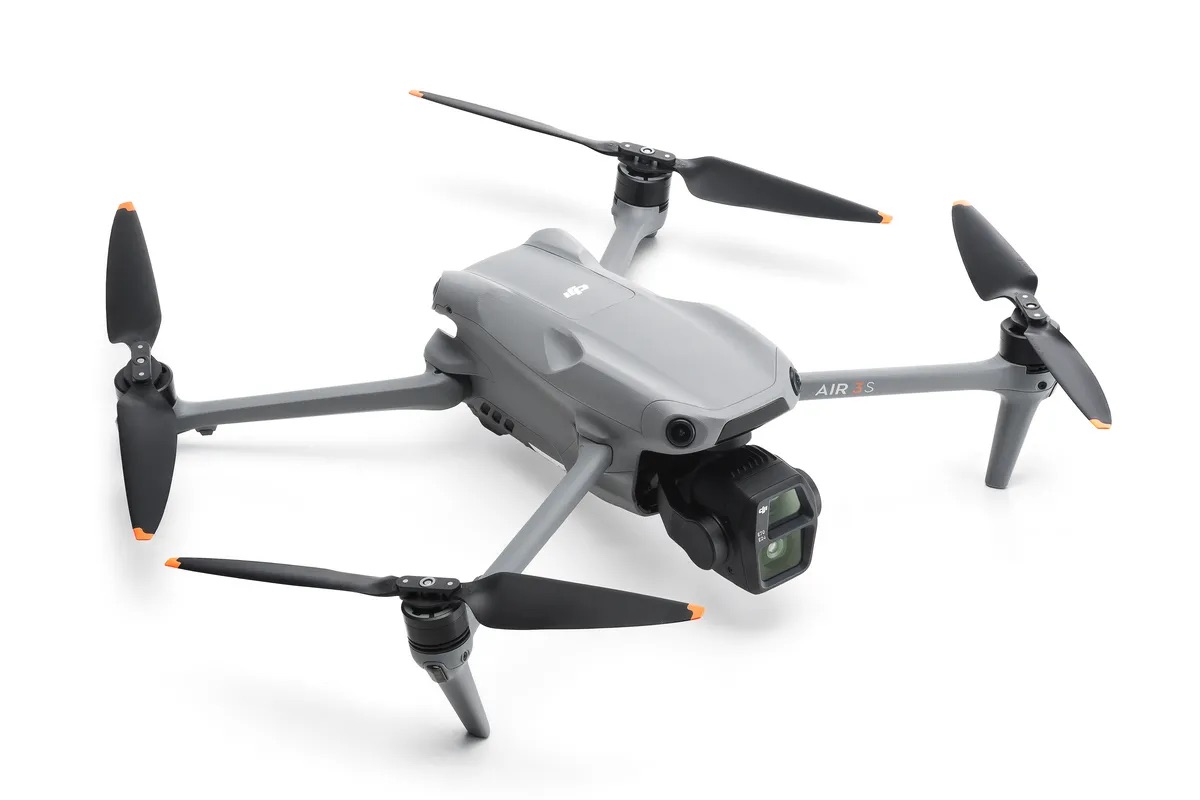
The DJI Air 3S is a more than welcome upgrade over its predecessor, the DJI Air 3.
2. The Best All-Rounder: DJI Air 3S
This drone is likely the best option for most people. The recently released DJI Air 3S turned into a DJI Air 3, or even a DJI Mini 4 Pro, on steroids. While the DJI Air 3S is an incremental update over the DJI Air 3, the improvements are definitely noteworthy. It doesn’t just sport 2 lenses (and 2 sensors), it also comes with dramatically improved obstacle avoidance (LiDAR), Ocusync 4 for a better transmission, and much greater flight times (45+ minutes). The main camera now has a very capable 1″ sensor, which shines in low light conditions. With this drone you can achieve high-quality photographs when using the techniques described in my drone photography e-book.
What I Like
- The extended battery life compared to cheaper drones is very welcome and will allow you to feel less stressed while also increasing the number of photographs you can take during your flights.
- Having an additional focal length increases the number of perspectives you get when photographing.
- The main camera has a 1″ sensor, which is dramatically improved over the cheaper drone models. It is also very capable in lower light conditions.
- It’s possible to transfer the power of almost empty batteries to other batteries to optimise battery usage.
- The wind resistance is excellent in strong winds.
- The Ocusync 4 transmission provides better range and smoother transmissions.
- The DJI RC2 remote controller, which comes with the drone, has external antennas.
What I Don’t Like
- The image sensor is only 12 megapixels, which means less qualitative images with less resolution compared to more expensive drones.
- Single shots aren’t particularly usable for prints.
- Taking bracketed shots can take much longer than on more expensive drones.
- The battery charging dock is large and feels unnecessarily bulky.
If you want a more detailed look at the DJI Air 3S, make sure to have a look at my detailed preview.
Buy the DJI Air 3S: https://geni.us/jvn-air3s
See the full specifications: https://www.dji.com/air-3s/specs
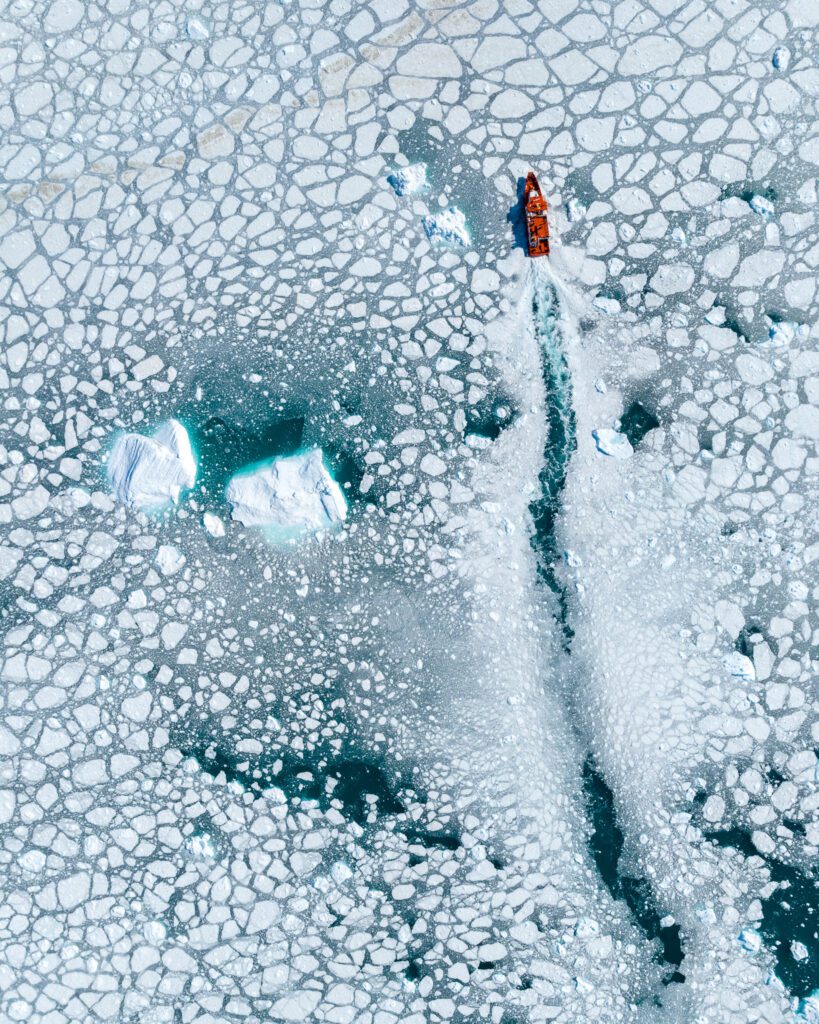
The high quality and high resolution images produced by these drones is next to none in the prosumer category.
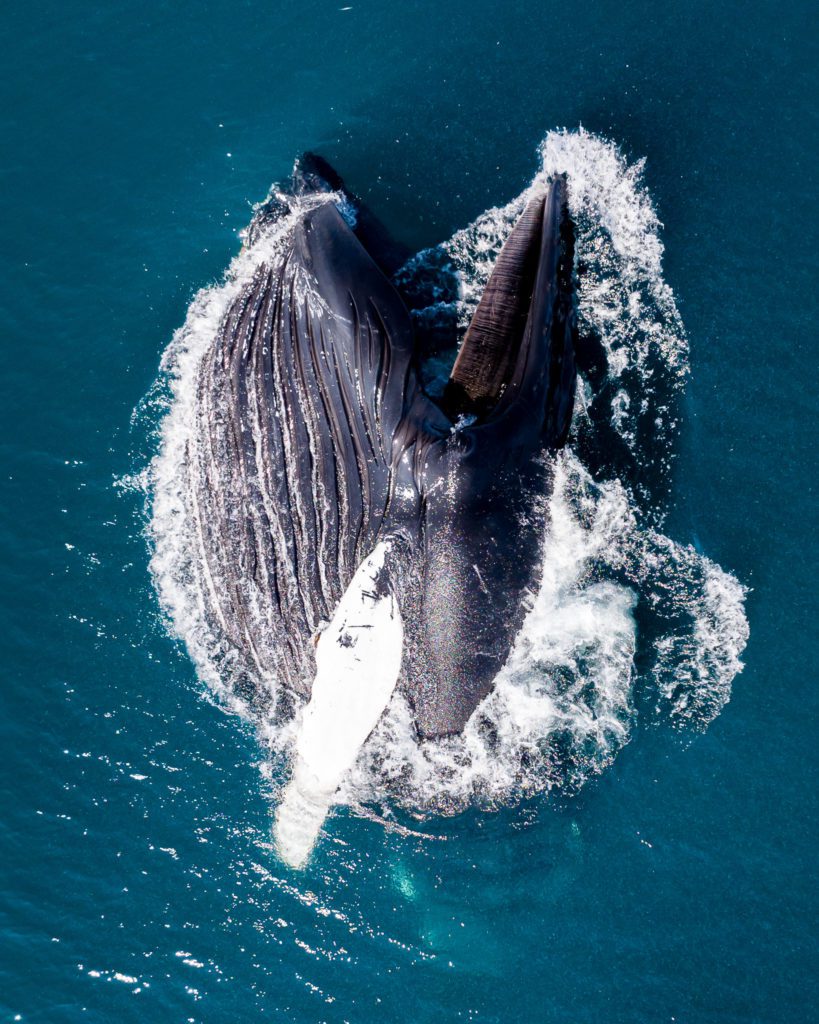
The Mavic 4 Pro’s wide angle camera allows you to capture high detail single shots, with room to crop if needed.
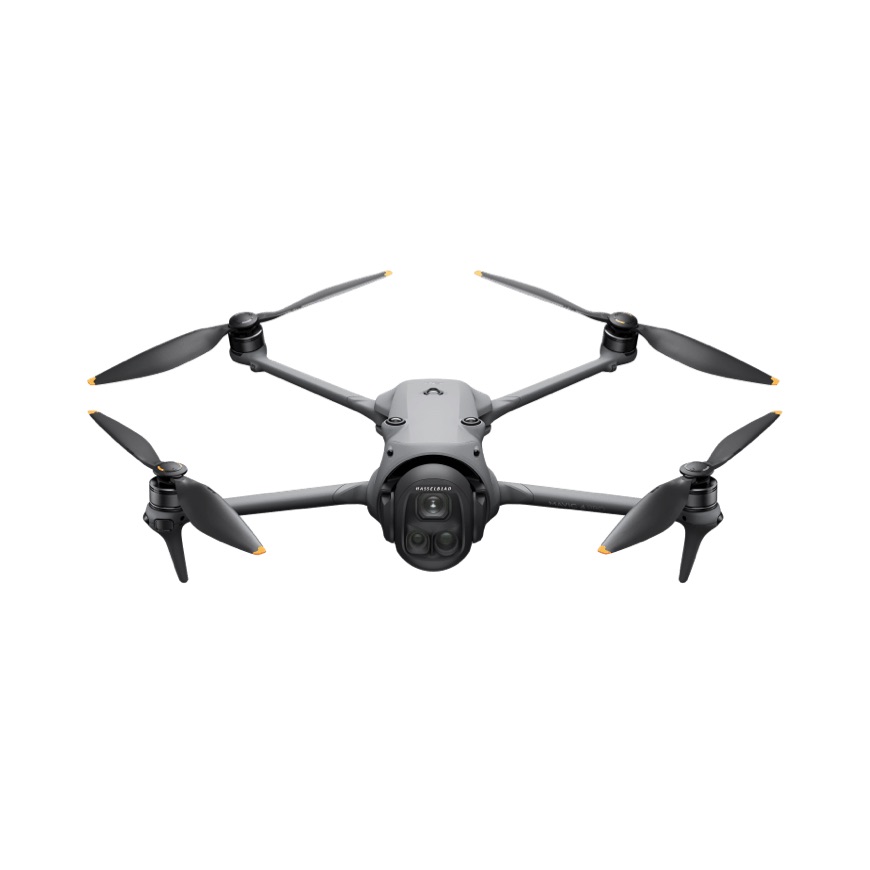
The DJI Mavic 4 Pro is the largest and most expensive prosumer drone today but delivers outstanding quality and possibilities.
3. The Premium Choice: DJI Mavic 4 Pro
While there is always something bigger & better in the drone world (eg. DJI Inspire 3 with a full-frame camera), the most realistic high-end choice for consumers and prosumer photographers today is the DJI Mavic 4 Pro. The DJI Mavic 4 Pro is a 3-camera powerhouse. It carries a 25 megapixel Micro Four Thirds wide-angle camera (1x), a 12 megapixel 1/1.3″ telephoto camera (2.5x) and a 1/1.5″ telephoto camera (6x). It offers the best of the best in the foldable drone category.
What I Like
- The wide-angle camera has an excellent 4/3 sensor with great image quality, superb dynamic range and a 25 megapixel resolution.
- This drone, being as heavy as it is, means that it’s very stable in strong winds.
- The obstacle avoidance is best-in-class and even works in extremely low light situations.
- The transmission technology, OcuSync 4+ is extremely reliable.
- The battery life is excellent!
- The wide-angle lens has a variable aperture.
- Having two additional focal lengths greatly increases the variety of shots you can take using this drone.
- The 3x telephoto lens uses the great sensor from the DJI Mini 4 (Pro) and DJI Air 3.
- The charging brick allows parallel charging, which means you can charge up to three batteries at the same time.
What I Don’t Like
- The DJI Mavic 4 Pro is very expensive.
- The footprint of the drone is large and adds a considerable weight to your photography backpack (1063 gram).
- It is classed as a C2 drone, which means stricter regulations and additional certifications apply.
- Each focal length has a different sensor with different quality and image resolution.
- The camera settings are unique between focal lengths, which can get confusing when changing between lenses.
If you want to know more, I published my first thoughts on the brand-new DJI Mavic 4 Pro. Read it on my blog!
Buy the DJI Mavic 4 Pro: https://geni.us/jvn-mavic4pro
See the full specifications: https://www.dji.com/mavic-4-pro/specs
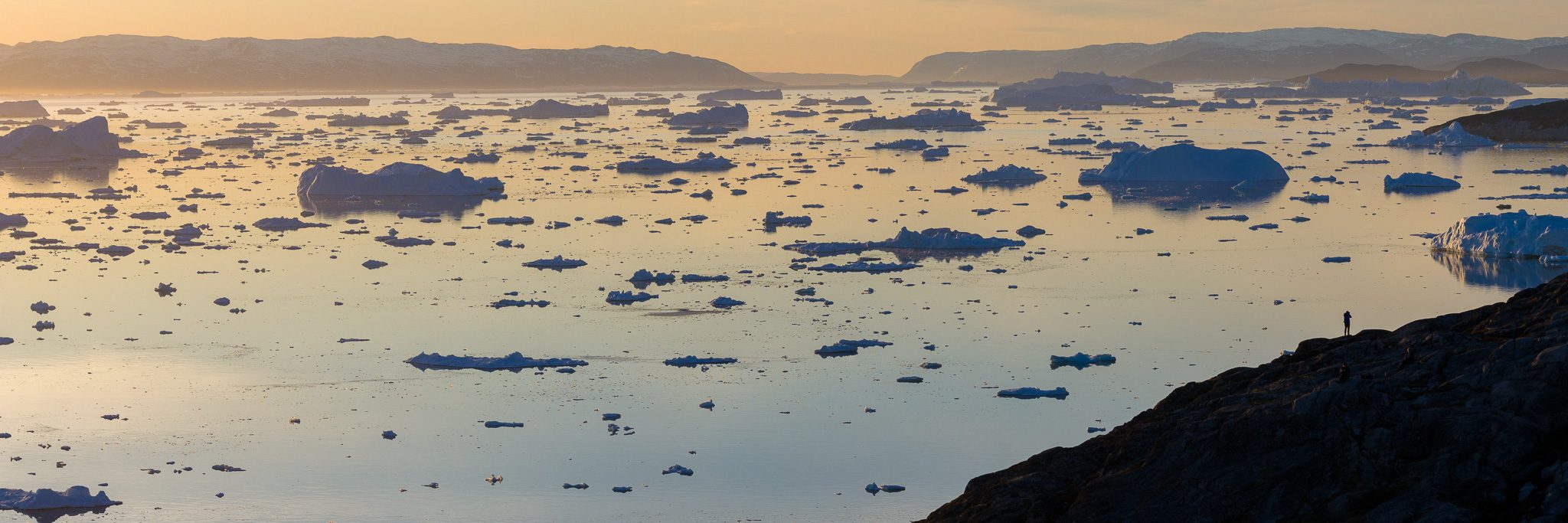
The use of the telephoto cameras on more recent drones has opened up a new world to me. I can revisit locations and photograph them from different angles and perspectives.
These Drones Are Still Relevant in 2025 for Photography
While the previously mentioned drones are the most likely choices on the market today, there are still a lot of older and still relevant drones available. These drones are likely to be cheaper than their newer counterparts while still providing you with good image quality. These can be good options if you can find them for a good price on the second-hand or discounted market.
1. DJI Air 3
The DJI Air 3 is somewhat of a DJI Mini 3/4 Pro on steroids. While it doesn’t only sport 2 lenses (and 2 sensors), it also comes with better obstacle avoidance, Ocusync 4 for a better transmission, and much greater flight times (40+ minutes). However, the Air 3 is quite a bit heavier than its predecessor, the DJI Air 2s, while also having a smaller sensor with less resolution (12mp 1/1.3 inch sensor vs a 20mp 1 inch sensor).
Buy the DJI Air 3: https://geni.us/jvn-air3
See the full specifications: https://www.dji.com/air-3/specs
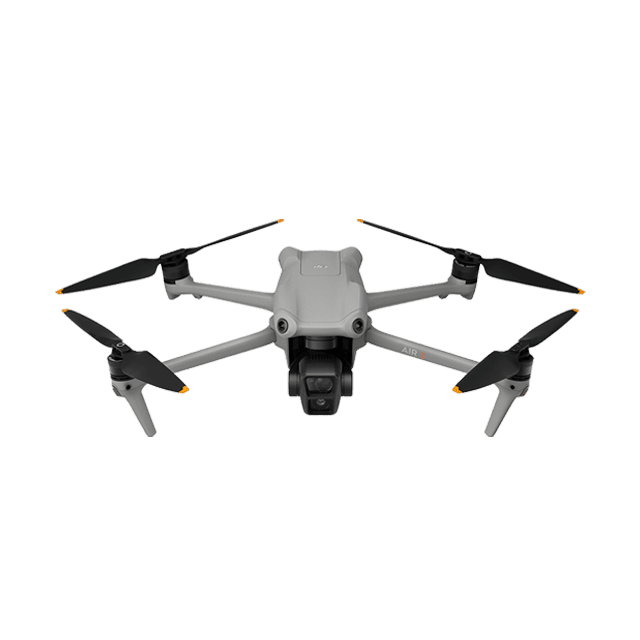
The DJI Air 3 is a very capable drone for most starting drone & aerial photographers.
2. DJI Mavic 3 Pro & DJI Mavic 3 Classic
Building on the success of the original Mavic 3, the DJI Mavic 3 Pro & DJI Mavic 3 Classic are solid photography workhorses. Both of them come with the same great wide-angle camera (and sensor) of the Mavic 3. While the DJI Mavic 3 Classic has a single camera, the DJI Mavic 3 Pro has an additional 3x telephoto lens and a 7x telephoto camera. I also wrote a detailed 6-month review on the DJI Mavic 3 Pro in case you need any convincing.
Buy the DJI Mavic 3 Classic: https://geni.us/jvn-mavic3classic
See the full specifications: https://www.dji.com/mavic-3-classic/specs
Buy the DJI Mavic 3 Pro: https://geni.us/jvn-mavic3pro
See the full specifications: https://www.dji.com/mavic-3-pro/specs
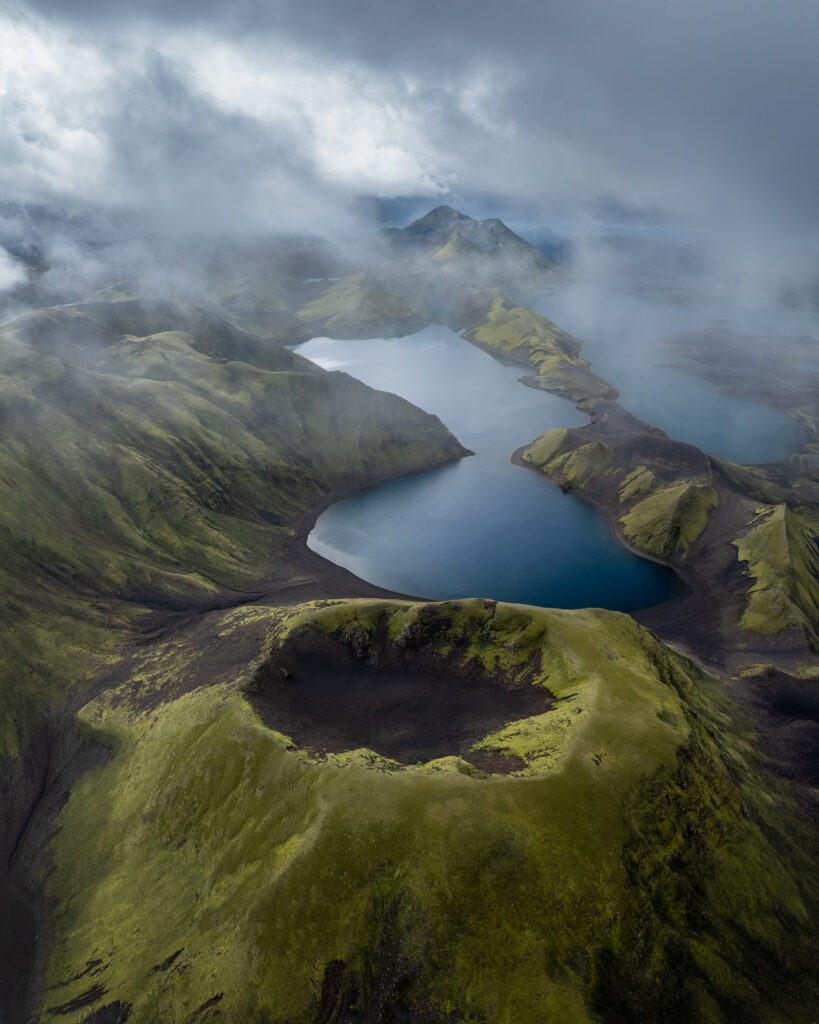
Even though the DJI Mavic 4 Pro is now available, it doesn’t make the predecessors any less capable. I have flown hundreds of hours with these drones and captured stellar images with them.
3. DJI Mavic 3
When the DJI Mavic 3 Pro came to market, it was replacing the original Mavic 3. The original Mavic 3 comes with the same great wide-angle camera (and sensor) and has almost all the same features of the Pro model. The only real difference is the lack of 3x telephoto lens and a worse 7x telephoto camera on the original model. However, this drone can still be found in some stores and is sometimes cheaper than the DJI Mavic 3 Classic.
Buy the DJI Mavic 3: https://geni.us/jvn-mavic3
See the full specifications: https://www.dji.com/mavic-3/specs
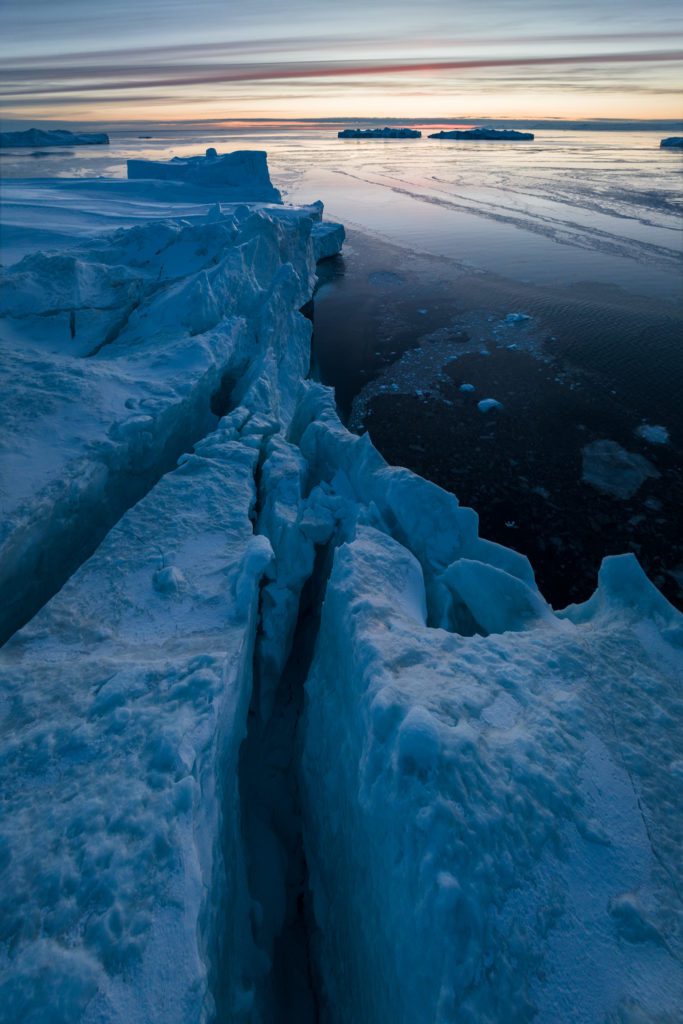
While I didn’t use the Mavic 3 specifically, the images you get out of the wide-angle lens are the same quality as those of the Mavic 3 Classic and Pro.
4. DJI Air 2s
I used the DJI Air 2s for a year and a half before I replaced it in favour of a model with more battery life. I always enjoyed using this nifty little drone as the image quality was the same as my beloved DJI Mavic 2 Pro. The only downside in comparison was the lack of variable aperture. However, the image quality of the 1 inch sensor and the 20 megapixel resolution really appealed to me.
Buy the DJI Air 2s: https://geni.us/jvn-djiair2s
See the full specifications: https://www.dji.com/air-2s/specs
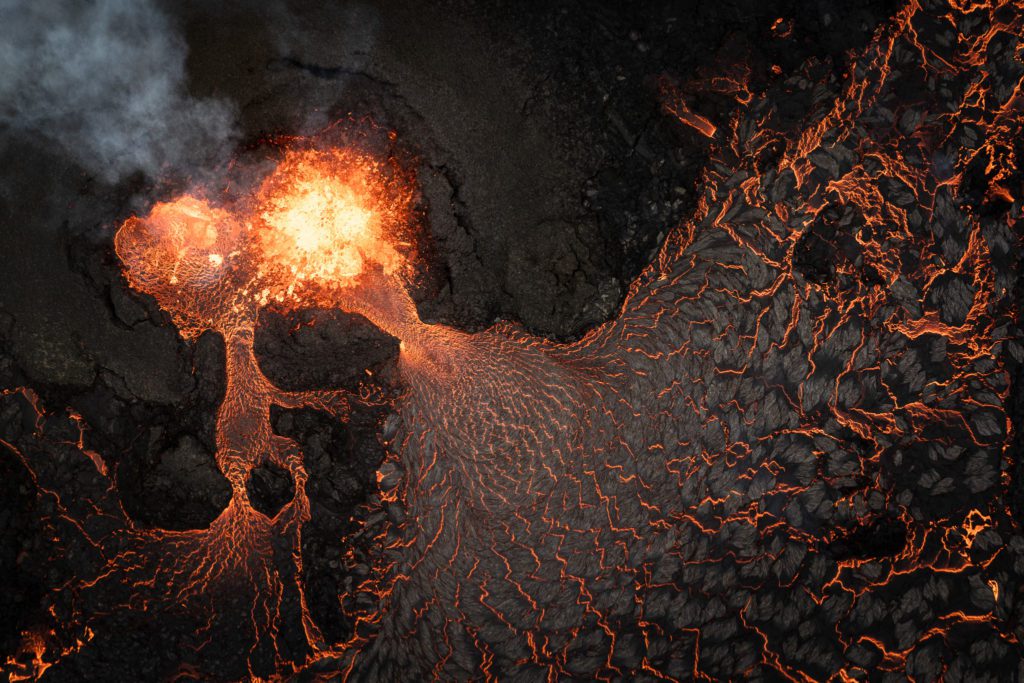
I put the DJI Air 2s through its paces and managed to capture some of my favourite images to date. Even though it’s small, it’s more than capable if you can deal with the limited battery life (compared to more modern drones).
5. DJI Mavic 2 Pro
The DJI Mavic 2 Pro was long the most used drone for drone photographers and videographers. I have great memories using one and I even captured some of my best shots using it. Even when the Mavic 3 came out, the benefits over the Mavic 2 Pro were marginal (leaving the increased battery life out of the equation). Having an excellent one inch sensor, with 20 megapixel resolution, and a variable aperture meant you could capture high quality images with this compact drone. Today it can be difficult to find them but if you can get one for a good price, it’s definitely still a good companion.
Buy the DJI Mavic 2 Pro: https://geni.us/jvn-mavic2pro
See the full specifications: https://www.dji.com/mavic-2/info#specs
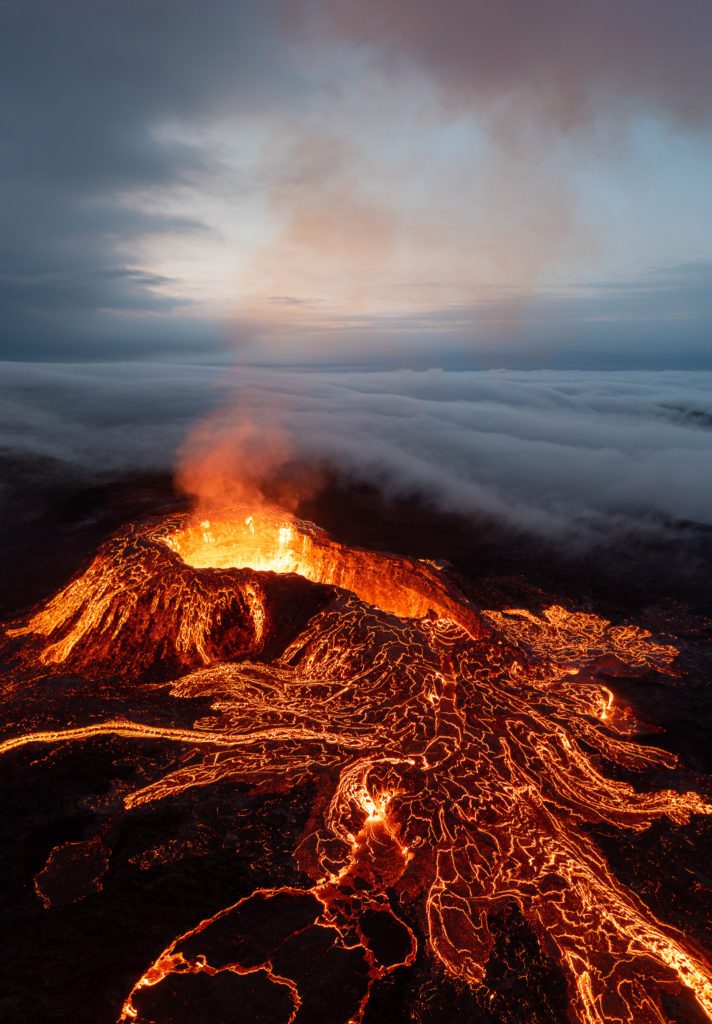
This award-winning photograph was captured using the DJI Mavic 2 Pro by using the techniques outlined in my drone photography e-book.
JUST RELEASED!
The Drone Photography Masterclass
Nigel Danson & Jeroen Van Nieuwenhove‘s complete drone masterclass will explore everything you need to know to start creating the best aerial photographs using any type of drone in 50+ detailed videos. Whether you are a complete beginner or an advanced drone pilot, this video course contains a vast amount of information to level up your drone photography skills.
Learn Drone Photography With My E-Book
Want to learn how to get the best results with your newly purchased drone? I wrote the most comprehensive guide available on drone photography which teaches you a technique to get the DSLR-like results out of even the cheapest drones.
In 125 detailed pages I explore everything you need to know to start creating the best photographs using any type of drone. Whether you are a complete beginner or an advanced drone pilot, this e-book contains a vast amount of information to level up your drone photography skills.
What to Expect?
- A 125-page educational PDF about nature drone photography with very detailed explanations
- Which drone to get for photography and why
- Important settings and configuration options
- A list of useful skills & tips
- A list of useful accessories and what not to buy at all
- How to research locations for drone photography
- How to compose with a drone and insight into Jeroen’s thought process with plenty of examples
- Thoughtfully planning ahead for your drone shoot
- The how and why of creating bracketed images
- The how and why of shooting HDR panoramas
- What challenges you might face and how to deal with them
- Common mistakes & how to deal with them
- How to stitch your panoramas together
Use EBOOK20 to get 20% off your Nature Drone Photography (E-Book) purchase!
Support Jeroen’s Work
As an independent photographer, Jeroen partially relies on your support to keep producing worthwhile content such as blogs, photographs, books and much more. If you want to support his work, it is possible to do so by buying his e-books & books, prints or calendars.
You can also sign up to the newsletter to stay up to date on new blog posts, projects, workshops and other interesting information.
Thank you for considering!

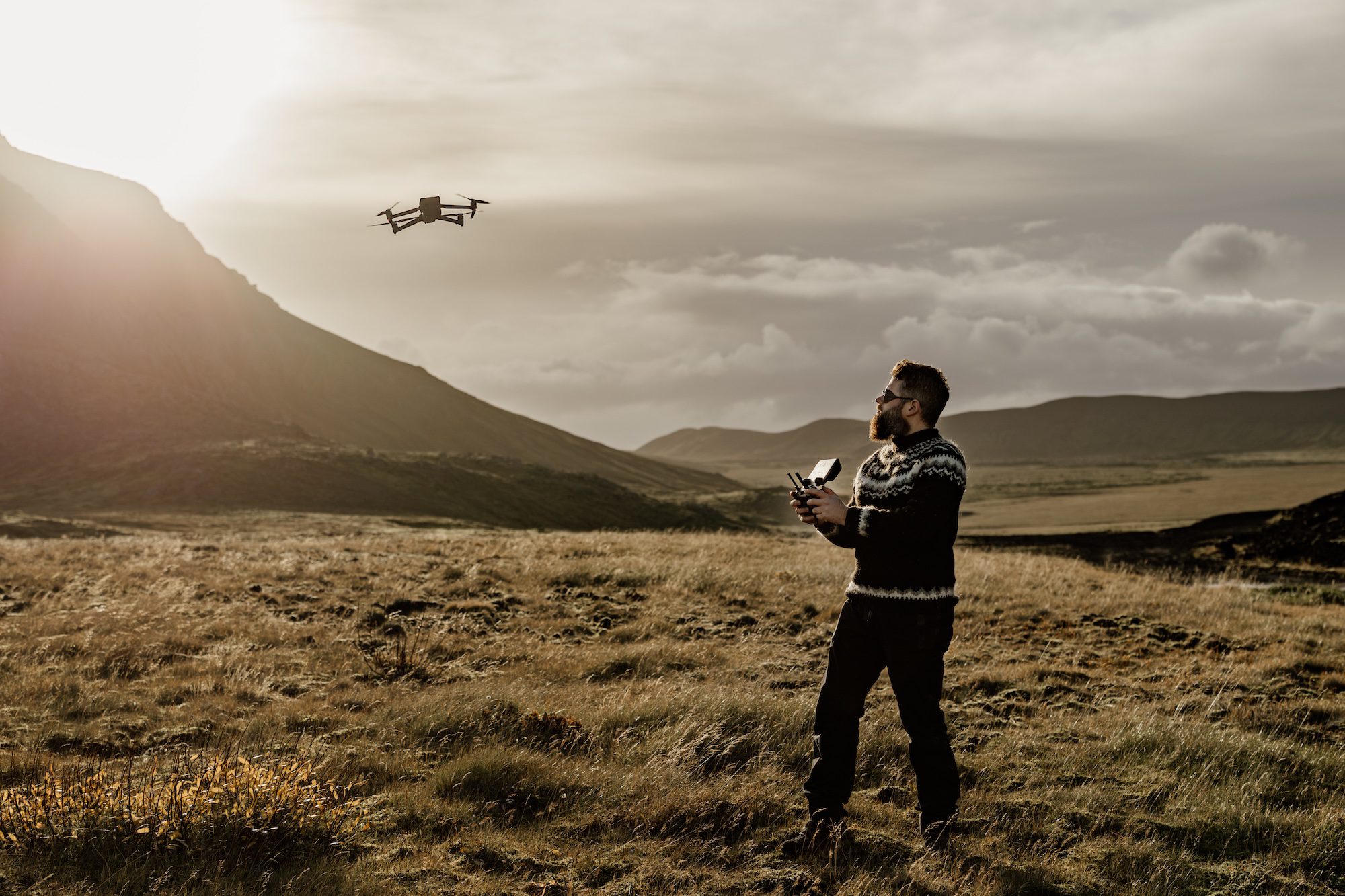
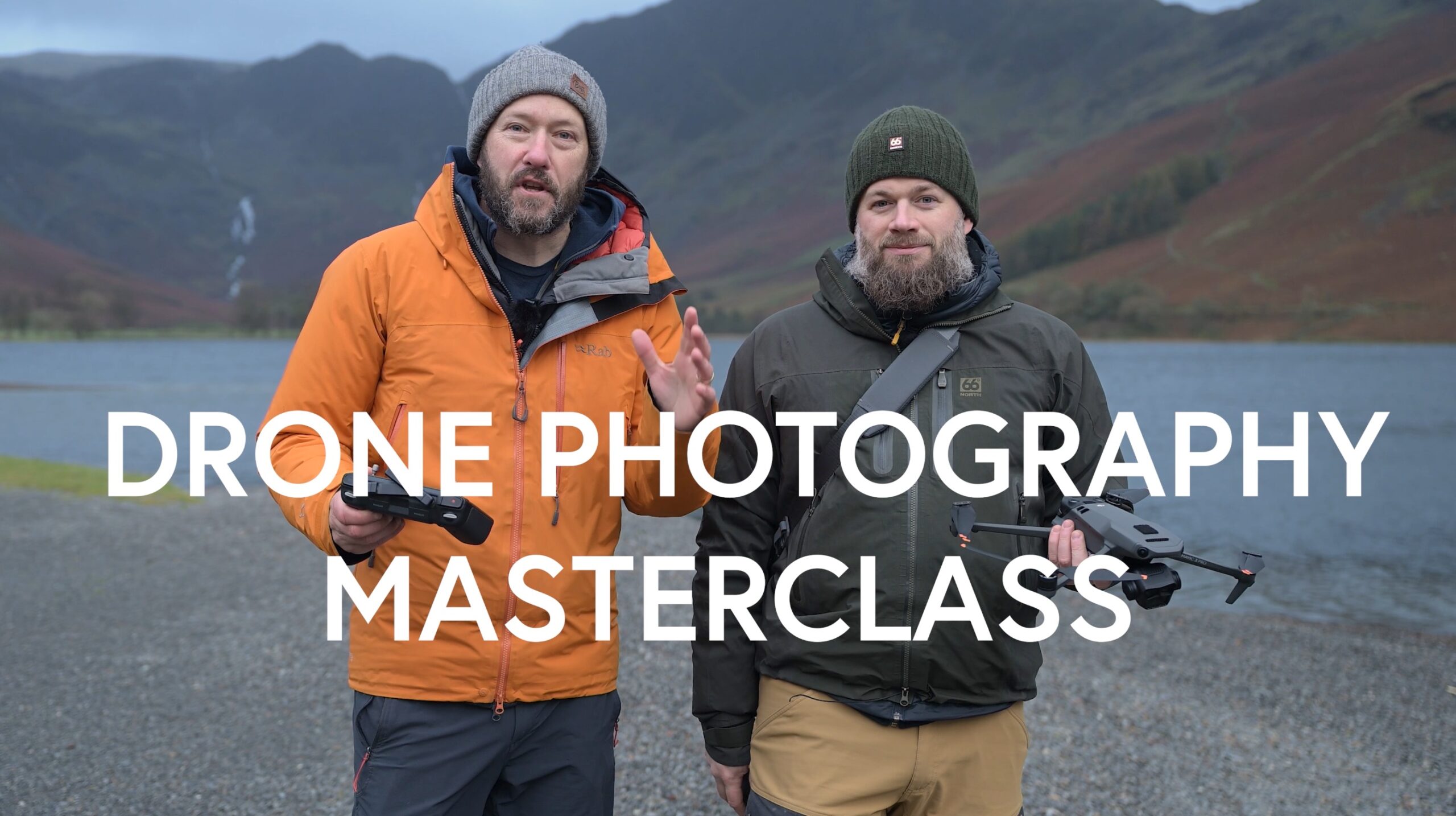
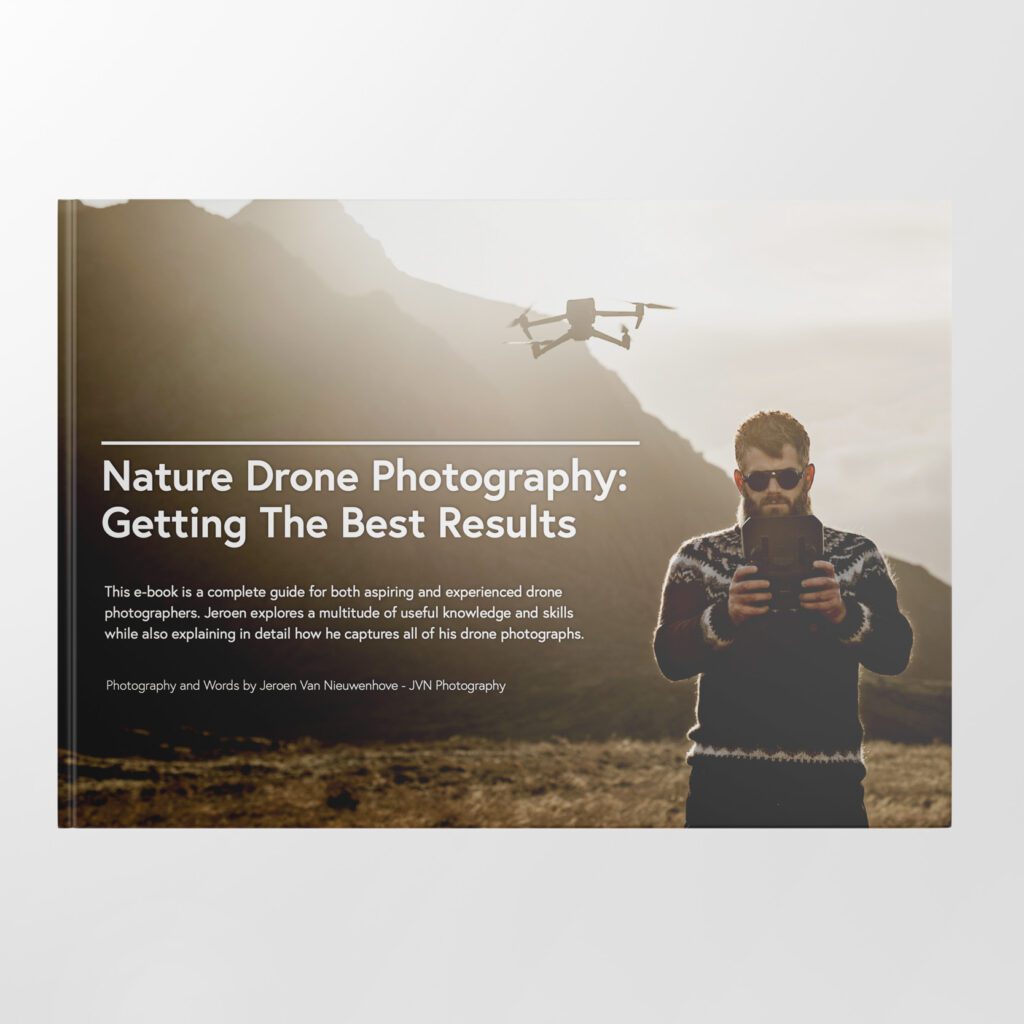
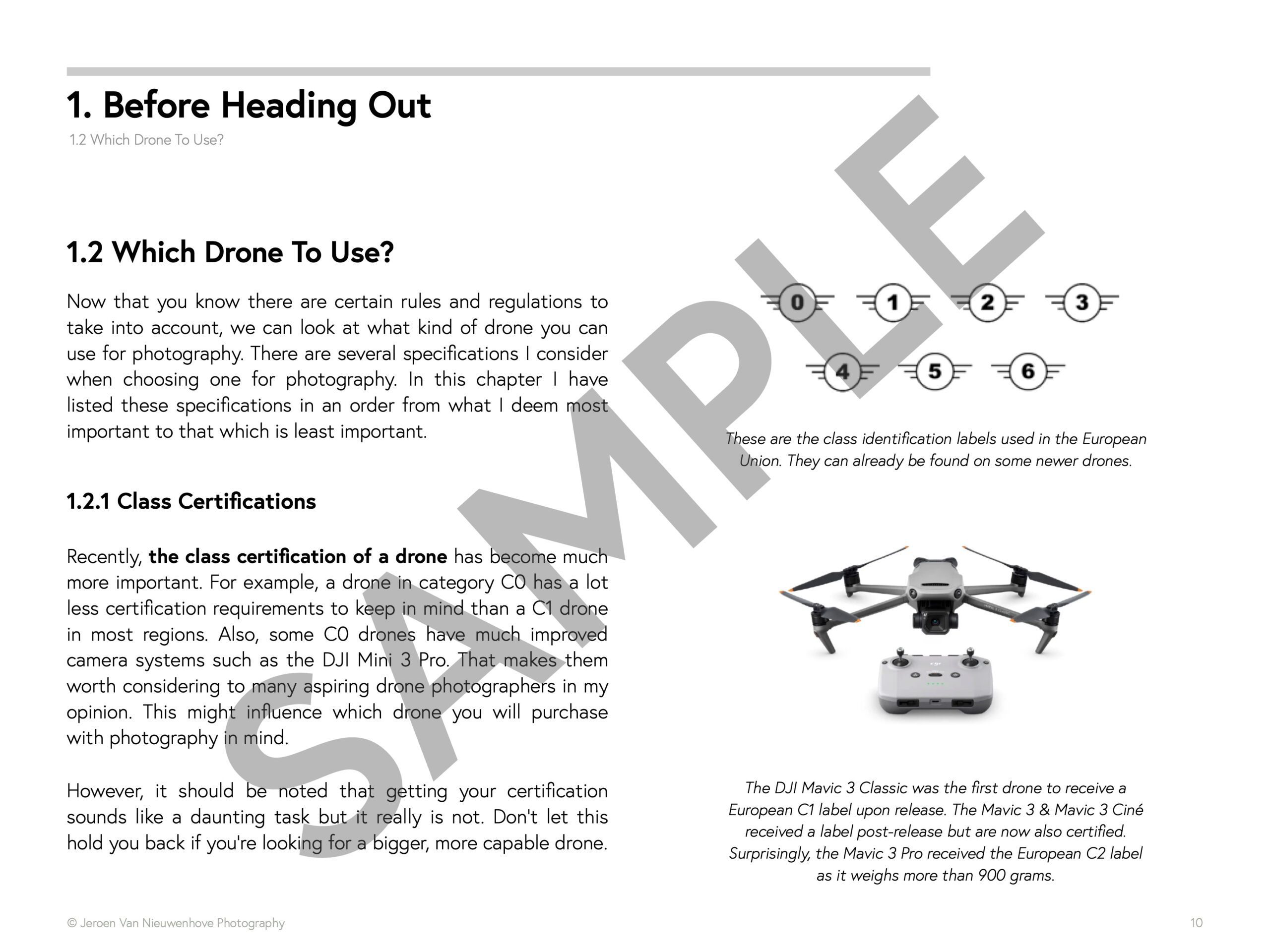

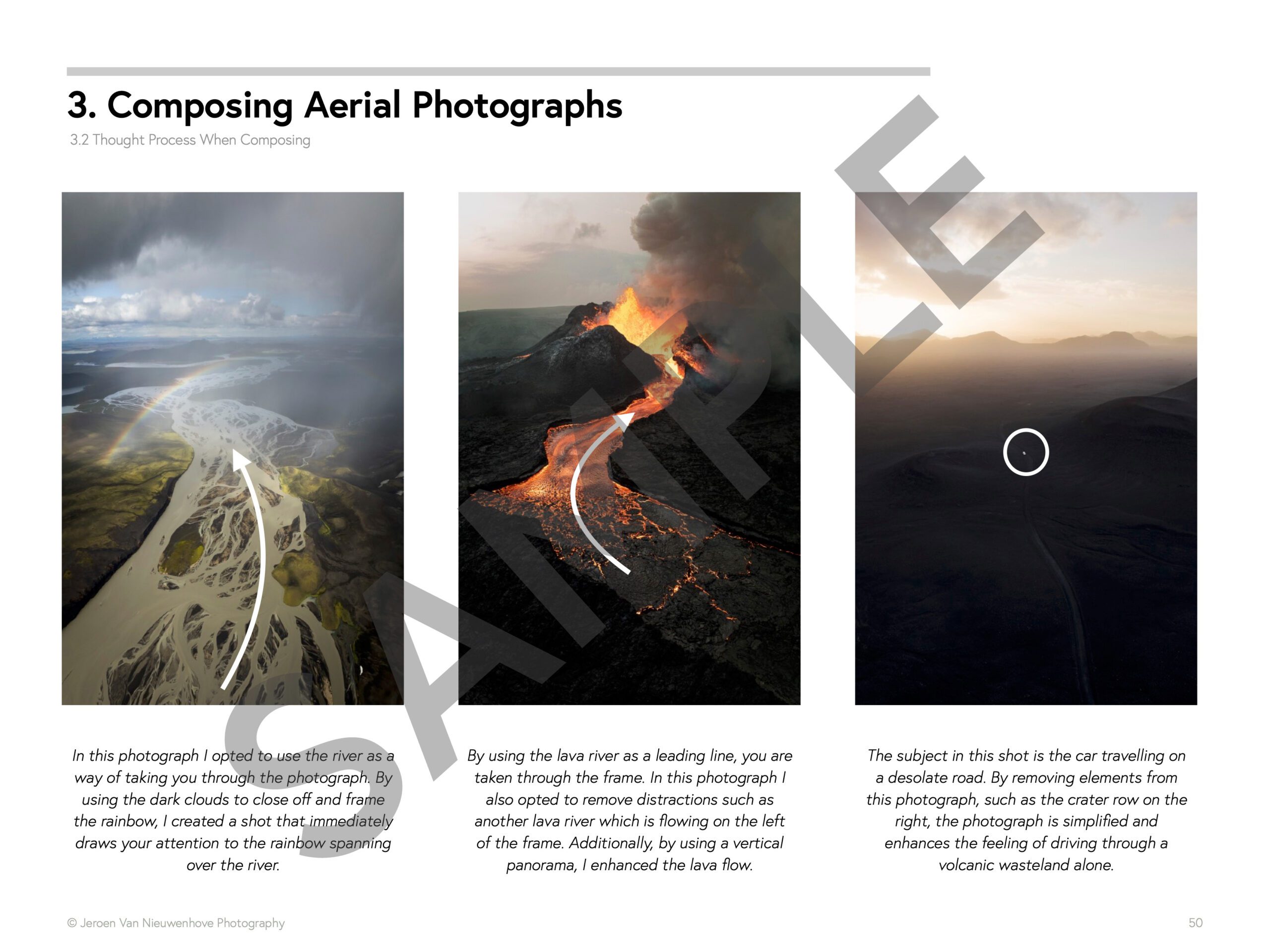
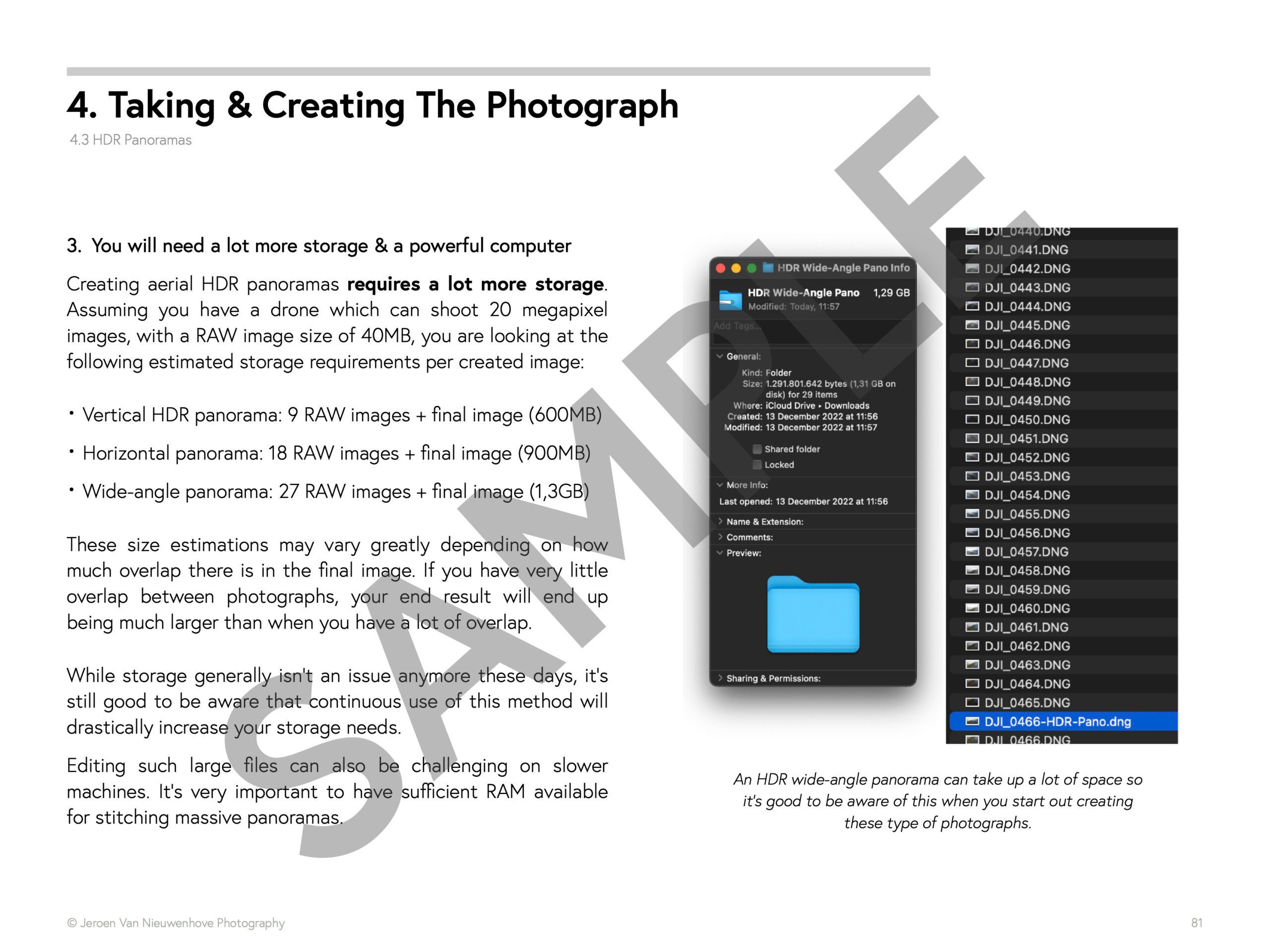
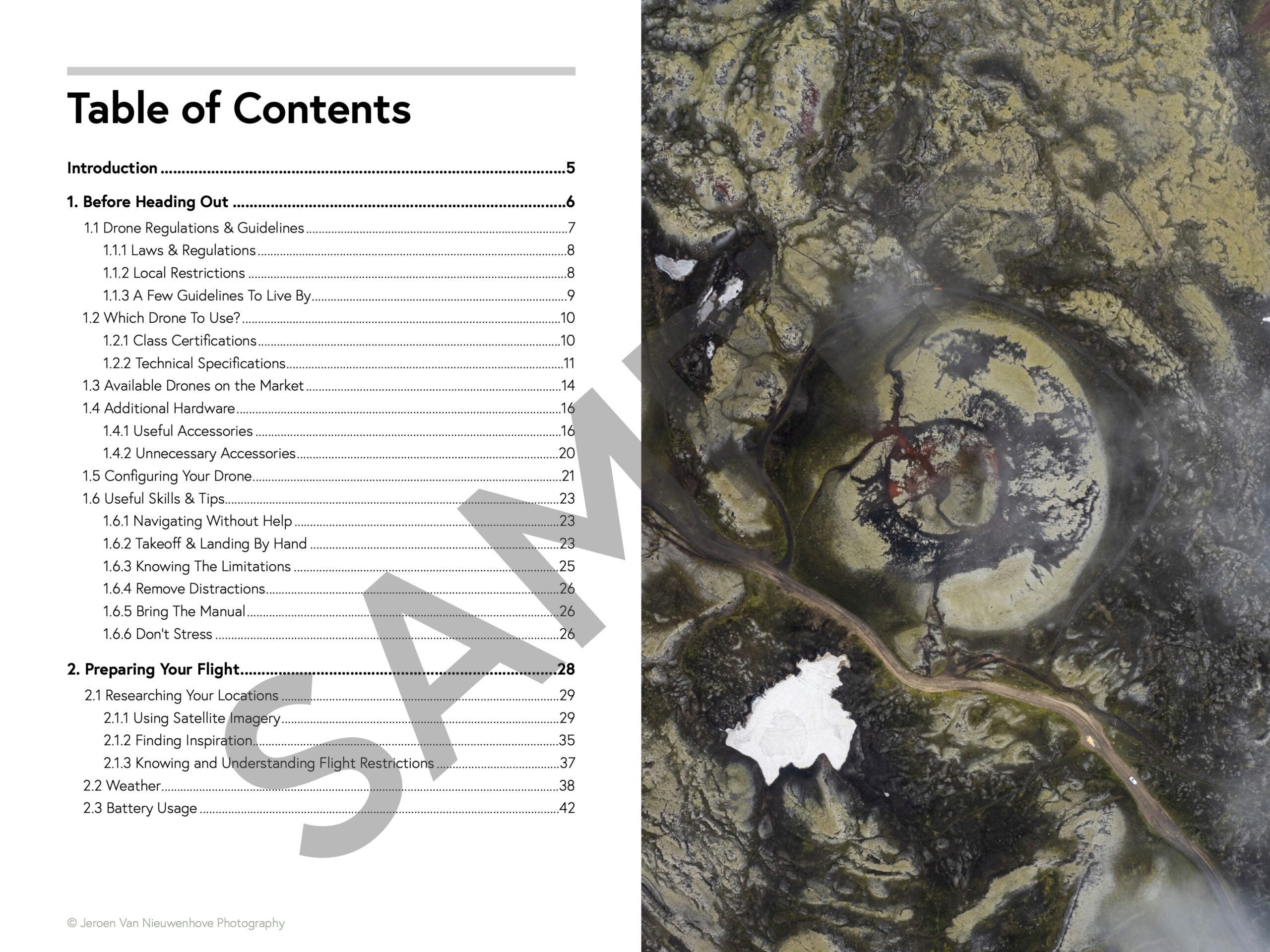

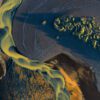
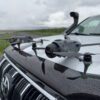


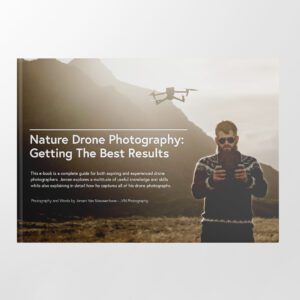
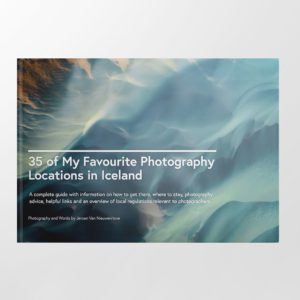
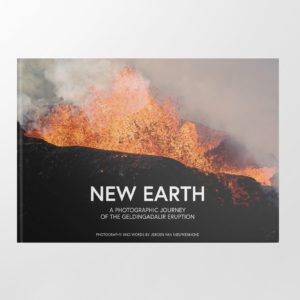

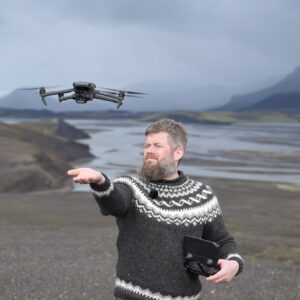

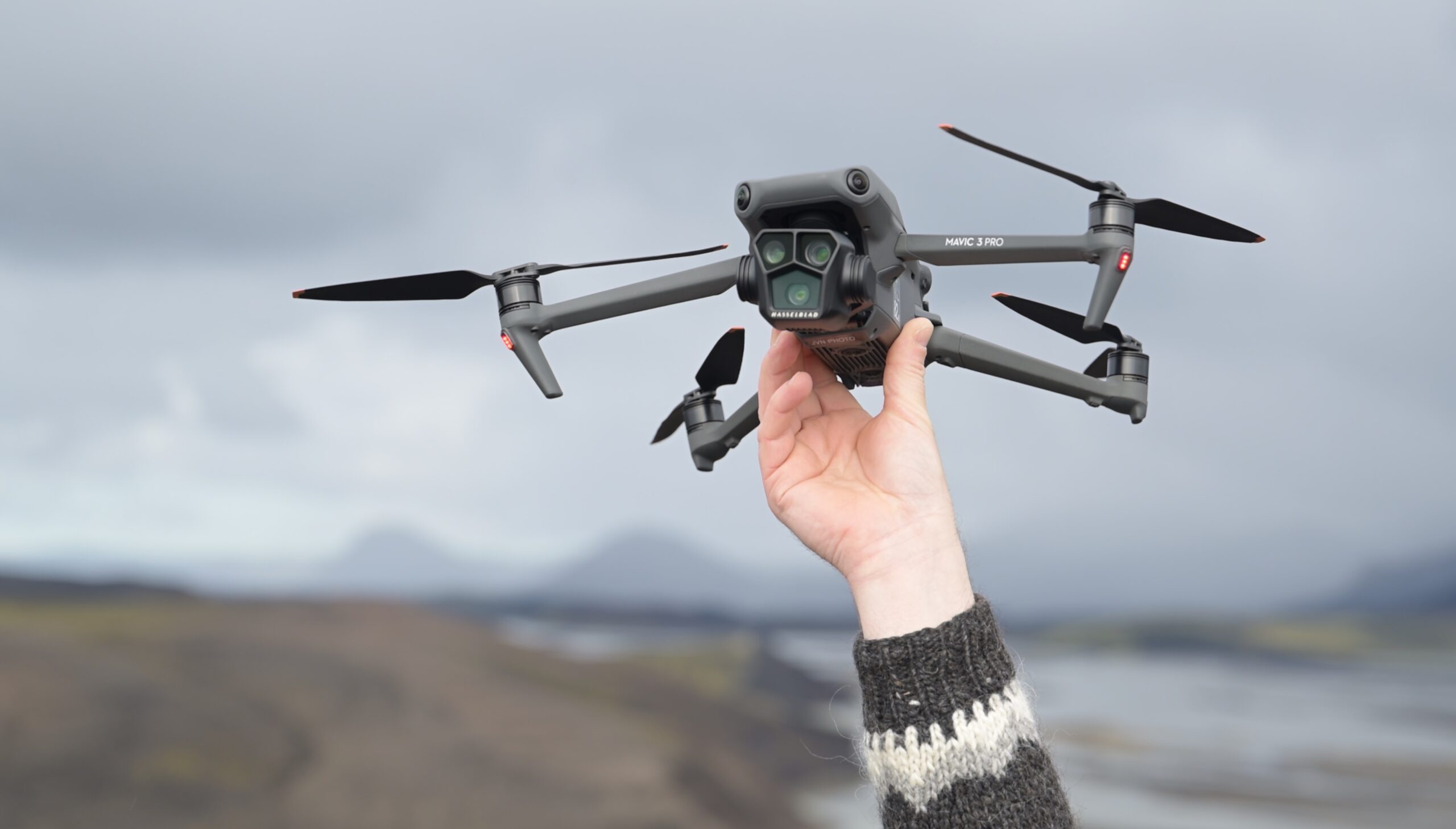
Your guide to choosing the perfect drone for photography is invaluable, especially for those prioritizing image quality. The DJI Mini 3 & Mini 3 Pro offer surprising capabilities despite their compact size, while the DJI Air 3 provides versatility with extended battery life and additional focal lengths. For premium quality, the DJI Mavic 3 Classic or Pro are standout options. Have you explored the potential of sport drones for capturing dynamic aerial shots as well?
Will I be able to use my Mavic 2 pro in Norway in 2024. The new firmware seems to only add RID for US. Thanks.
The older drones will be in their own category, which is ‘Legacy’. Legacy drones are in essence all drones that were sold before January 1st 2023. These drones can be flown in the A1 or the A2 subcategory of the Open Category (depending on how much they weigh).
Hi Jeroen, thanks for explaining and that makes sense! Would you happen to know any resources (YouTube etc.) where I could see any example prints from the Air 3 for myself? I can’t seem to find many resources about drone printing online, except your blog post!
The best way to see image quality is to look at the single shots coming from the DJI Mini 3 Pro. It has the same sensor as the main and telephoto cameras on the Air 3.
Hi Jeroen,
Thanks for this in-depth review! I’ve been looking to purchase a drone and was originally looking at the DJI Air 3 for aerial photography specifically for printing. Would you mind going into more detail around your comment that single shots aren’t particularly usable for prints? Just wondering if you’d have a different recommendation such as the Mavic 3 Classic. Thanks again and look forward to hearing from you!
Hi Lee, thanks for your kind words. The reason I wouldn’t recommend single shots is the fact that the images are 12 megapixels only, coming from a small sensor. While there is a 48 megapixel mode, it doesn’t look better than upscaling an image in post due to the fact this is using quad-bayer sensor technology. It’s a fun party trick but I don’t find the quality to be sufficient. On top of that, the process of taking photos at that resolution is really really slow. The Mavic 3 series main camera has a 20 megapixel sensor, which is micro 4/3, and has very good single image quality. Although I have to say that if you use the techniques I detail in my Drone Photography e-book, you can get DSLR quality images out of even the smallest drones and smallest sensors. I hope that helps!
Thank you for the information without having any bias. This is a great insight.
Thank you! I am glad to read it helped you!